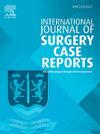A case report of mandibular aggressive fibromatosis in a pediatric patient: diagnostic challenges and surgical management
IF 0.6
Q4 SURGERY
引用次数: 0
Abstract
Introduction
Aggressive fibromatosis (AF) of the mandible is a rare, locally invasive tumor with significant diagnostic and therapeutic challenges. The incidence of AF in the head and neck region is estimated at 2–4 cases per 10 million people annually, with mandibular involvement being even less common. Its infiltrative nature and high recurrence risk necessitate meticulous surgical planning and prolonged follow-up.
Case presentation
A 15-year-old male presented with progressive left mandibular swelling and pain initially misdiagnosed as acute pulpitis. Imaging revealed a large soft tissue mass (64 mm × 68 mm) surrounding the left mandible with local bone destruction. Histopathological examination confirmed the diagnosis of aggressive fibromatosis. The patient underwent en bloc resection of the affected mandibular body and partial ramus, with preservation of vital structures. Despite conservative resection with 1–1.5 cm surgical margins, the patient experienced recurrence at 14 months post-surgery and underwent subsequent expanded tumor excision with mandibular segmental resection and fibular reconstruction at another institution.
Discussion
This case highlights the importance of accurate diagnosis and appropriate surgical management of mandibular AF. While our initial conservative approach was driven by economic constraints, the eventual recurrence necessitated more extensive surgery, emphasizing the importance of adequate surgical margins for this aggressive lesion.
Conclusion
Mandibular AF requires a comprehensive diagnostic approach and careful surgical planning. Clear surgical margins are essential to minimize recurrence risk, even if reconstruction must be delayed due to economic constraints. Long-term multidisciplinary follow-up is critical in pediatric cases both for tumor surveillance and to address developmental needs.
儿科患者下颌骨侵袭性纤维瘤病病例报告:诊断难题与手术治疗
本文章由计算机程序翻译,如有差异,请以英文原文为准。
求助全文
约1分钟内获得全文
求助全文
来源期刊
CiteScore
1.10
自引率
0.00%
发文量
1116
审稿时长
46 days

 求助内容:
求助内容: 应助结果提醒方式:
应助结果提醒方式:


